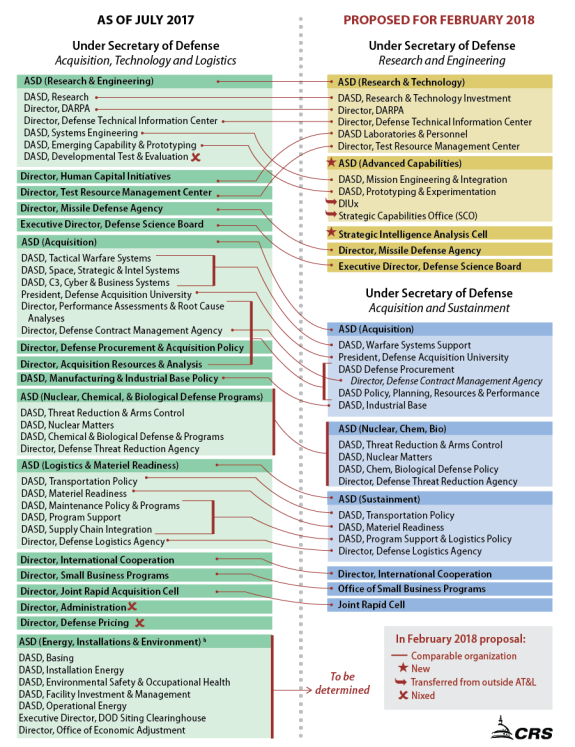On August 2, 2017, DOD provided Congress its plan for breaking the Office of the Secretary of Defense's acquisition office—the Under Secretary of Defense (USD) for Acquisition, Technology and Logistics (AT&L)—into two separate organizations, as required by the FY2017 National Defense Authorization Act (NDAA), Section 901. The NDAA conference report laid out the concerns that drove the split:
"Three broad priorities framed the conference discussions: (1) elevate the mission of advancing technology and innovation within the Department; (2) foster distinct technology and acquisition cultures to better deliver superior capabilities for the armed forces; and (3) provide greater oversight and management of the Department's Fourth Estate."
The Fourth Estate usually refers to those components of DOD not part of the Departments of Army, Navy, or Air Force. In addition to splitting USD AT&L, the DOD plan also covers how the Chief Management Officer's organization will be restructured to meet Congress's stated third aim.
Context
The existing AT&L had evolved over time to take greater responsibility for overseeing the efficient procurement of weapons, especially the prevention of cost overruns. In 1986, Congress created the position of USD (Acquisition) to address concerns highlighted by a blue ribbon commission report:
"Responsibility for acquisition policy has become fragmented. There is today no single senior official in the Office of the Secretary of Defense working full-time to provide overall supervision of the acquisition system."
While there is little evidence this and successive organizational changes have decreased cost overruns, some observers have become concerned the current acquisition system was not sufficiently advocating for technological advances, especially given foreign militaries' modernization efforts. The FY2017 NDAA reflected these concerns in splitting AT&L.
DOD Plan
The DOD plan accepts the premise that a change in organization will encourage greater technological innovation. Under the plan, DOD will create one Under Secretary for Research and Engineering (USD (R&E)) —a more senior position— "with responsibility and authority for ensuring U.S. military technical superiority." A second Under Secretary for Acquisition and Sustainment (USD (A&S)) "will minimize further risk, as necessary to ensure the needed capability is delivered and sustained in the most timely and cost-effective manner possible."
The DOD plan lays out how existing subordinate organizations will be mapped to the new USDs. The FY2017 NDAA eliminated all statutorily required positions below the two new USDs. The DOD plan posits moving most existing organizations under one of the new USDs, creating some new organizations, and disbanding some old organizations; Figure 1 provides a crosswalk of these changes. Moreover, the DOD plan expects to make these changes while meeting the 25% reduction in headquarters personnel mandated by the FY2016 NDAA.
The new organization would mirror how DOD organized acquisition oversight in the 1950s. A 1953 reorganization created an Assistant Secretary for Research and Development, primarily focused on advancing the state of technology, and an Assistant Secretary for Applications Engineering, primarily focused on developing weapons systems efficiently and economically. Both reported to the Secretary of Defense. The two positions were dissolved in 1957. Their functions were statutorily enshrined in the creation of Director, Defense Research and Engineering, which eventually evolved into USD (AT&L) as described above.
Implementation
The formal roles are to take effect on February 1, 2018. DOD expects to establish USD (R&E) first, followed by USD (A&S). DOD expects it will require up to a year to complete the necessary personnel moves. The Strategic Intelligence Analysis Cell, which is to report to USD (R&E), is to form earlier to inform the existing budget process by analyzing how U.S. capabilities match up against enemy technological developments.
The Senate confirmed Ellen Lord in the existing USD (AT&L) role on August 1st, 2017, making her the senior official in charge of the reorganization. The FY2017 NDAA designated the incumbent AT&L as the USD (R&E) without further confirmation. Lord, however, testified in her confirmation hearing that she intended to serve as USD (A&S) when the organizations split. The Senate version of the FY2018 NDAA deletes the assumed incumbency and requires both positions be reconfirmed. As the DOD plan makes many actions contingent on the appointment of the new USDs, the changes may wait until these personnel decisions finalize.
The DOD plan also explicitly postpones some decisions. Most notably, the plan does not decide to whom one of the five existing USD (AT&L) assistant secretaries, ASD (Energy, Installations, and Environment), will report. DOD may move the organization out of the acquisition offices and place it under the Chief Management Officer, primarily to treat bases and property as a business operation in order to achieve cost savings and other efficiencies. Other organizations are assigned to one of the new USDs, but the final reporting chain is not clear. These include organizations currently responsible for unorthodox acquisition activities, such as the Strategic Capabilities Office (SCO) and Defense Innovation Unit-Experimental (DIUx), which are to be in USD (R&E).
Finally, the plan disbands some organizations charged with certain acquisition functions. The plan acknowledges those functions will still occur but does not clarify where in the new organization they will occur. These functions include, under USD (R&E), systems engineering and developmental test and evaluation and, under USD (A&S), performance assessments and root cause analyses.
